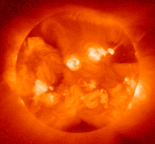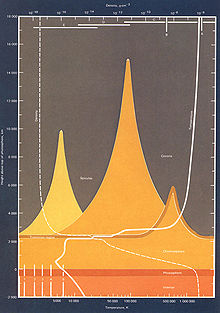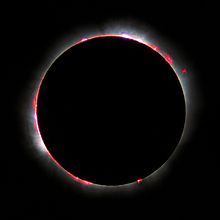- Chromosphere
-
The chromosphere (literally, "color sphere") is a thin layer of the Sun's atmosphere just above the photosphere, roughly 2,000 kilometers deep.
Although thin, its density increases over almost seven orders of magnitude (five million times) from a low of 1.0 × 10−11 kg/m3 (1.0 × 10−14 g/cm3) at its boundary with the solar transition region, and increasing to a high of 2.0 × 10−4 kg/m3 (2.0 × 10−7 g/cm3) where it merges into the photosphere.[1] See Figure 1. Skylab's solar atmosphere results chart for details of how its temperature and density vary with height.
The chromosphere is more visually transparent than the photosphere. The name comes from the fact that it has a reddish color, as the visual spectrum of the chromosphere is dominated by the deep red H-alpha spectral line of hydrogen. The coloration may be seen directly with the naked eye only during a total solar eclipse, where the chromosphere is briefly visible as a flash of color just as the visible edge of the photosphere disappears behind the Moon.
For reasons not fully understood, the temperature of the chromosphere is hotter than that of the photosphere. The photosphere is closer to the center of the sun and its temperature is around 4000 K to 6400 K but the chromosphere is about 4500 K to as high as 20,000 K.[2][3] One theory is that acoustic turbulence is the source of this higher temperature, as the result of the dispersion of magnetohydrodynamic waves over the solar surface.
Without special equipment the chromosphere cannot normally be seen owing to its being washed out by the overwhelming brightness of the photosphere. It can be seen clearly through special narrow-band optical filters tuned to the H-alpha spectral line, and many observatories routinely observe the chromosphere using this technique, which displays filaments quite clearly. Filaments (and prominences, which are filaments viewed from the side) underlie many coronal mass ejections and hence are important to prediction of space weather.
The most common solar feature within the chromosphere are spicules, long thin fingers of luminous gas which appear like the blades of a huge field of fiery grass growing upwards from the photosphere below. Spicules rise to the top of the chromosphere and then sink back down again over the course of about 10 minutes.
Another feature found in the chromosphere are fibrils, horizontal wisps of gas similar in extent to spicules but with about twice the duration.
Finally, solar prominences rise up through the chromosphere from the photosphere, sometimes reaching altitudes of 150,000 kilometers. These gigantic plumes of gas are the most spectacular of solar phenomena, aside from the less frequent solar flares.
Above the chromosphere of some stars there is a so-called transition region, where the temperature increases rapidly to the hot corona, which forms the outermost part of the atmosphere.
See the flash spectrum of the solar chromosphere (Eclipse of March 7, 1970).
See also
References
External links
- Animated explanation of the Chromosphere (and Transition Region) (University of Glamorgan).
- Animated explanation of the temperature of the Chromosphere (and Transition Region) (University of Glamorgan).
The Sun Internal structure 
Atmosphere Chromosphere- Transition region
- Coronal hole
- Coronal loop
- Coronal mass ejection
- Prominence
- Helmet streamer
Variation Heliosphere Related topics Categories:
Wikimedia Foundation. 2010.



